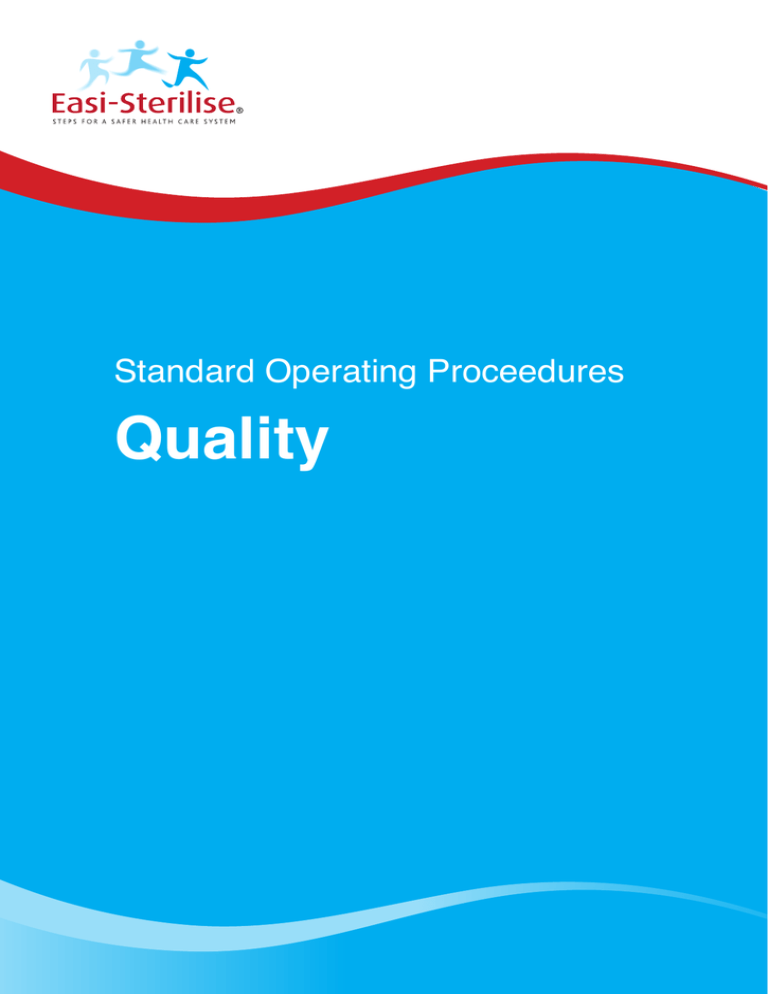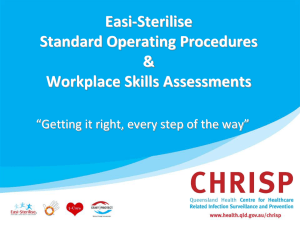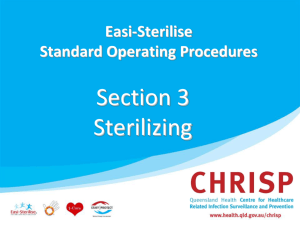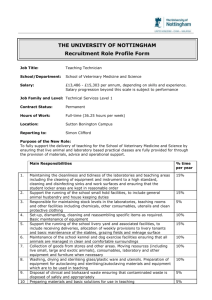EFFICIENCY TEST USING SOIL
advertisement

Standard Operating Proceedures Quality 5.1 WATER QUALITY PURPOSE To ensure water used in cleaning of re-usable medical devices is of optimum quality for effective and efficient processing Water Hardness: If a grey / white residue appears on the medical and surgical equipment after cleaning this can have a detrimental affect on the item and transference of this residue to a patient could have serious consequences and cause irritation to the patients surrounding tissues Hardness can affect the activity of the detergent used for cleaning and may require increased concentrations of detergent Certain chemical formulations are only designed for soft water use and will allow hard water salts to precipitate out OPERATING PROCEDURE Tests and Maintenance Water testing can either be conducted by maintenance departments, or test as per manufactures kit by sterilising services staff, or by chemical distribution representatives pH levels, water quality & chemical compatibility tests are carried out and recorded on a regular basis and any discrepancies are actioned and outcomes recorded Quarterly maintenance on the machine with temperature recordings being validated Detergent precipitation is particularly difficult to remove. In all cases precipitation is accelerated as water temperature increases. E.g. Initial wash temperature too high Report any residue left on instruments to the shift supervisor 5.1 WATER QUALITY NB. Hard water is high in minerals and can leave a residue on instruments and cleaning equipment. This can cause permanent damage and shorten the life of the instrument or machine and may also interfere with the action of the cleaning agent. Testing Frequency (not mandatory): Daily: o Detergent residue Weekly: o Water pH test o Water hardness At least monthly, and more frequently depending on water hardness results: o Chlorine/Chorine residue o Iron Recording and Documentation: Record all test results Retain test strips if applicable and affix to record/documentation Reference: AS/NZ4187 – Section 2 COMPETENT Meets current best practice requirements. Review annually. ADVANCED BEGINNER Requires re-assessment within 1 month. NOVICE Requires immediate action by manager to manage risk. Requires re-assessment in 1 week. 5.2 CLEANING EFFICACY TEST . PURPOSE To challenge the efficacy of the mechanical cleaners At commissioning of mechanical washer to determine loading patterns/configurations Weekly (not mandatory) Conduct tests according to manufactures instructions OPERATING PROCEDURE Failed Tests Notify the Shift Supervisor If any test fails and the machine placed out of action until the fault is rectified Possible Causes of Test Failure Overloading of baskets – impedes the free flow of water over items Material incompatibility Blocked jets in the machine Blocked water inlet filter on wash chamber Incorrect cycle temperatures Reference: AS/NZ4187 – Section 2 COMPETENT Meets current best practice requirements. Review annually. ADVANCED BEGINNER Requires re-assessment within 1 month. 5.2 CLEANING EFFICACY TEST Frequency of Testing NOVICE Requires immediate action by manager to manage risk. Requires re-assessment in 1 week. 5.3 ULTRASONIC MACHINE TESTING . PURPOSE To ensure that the machine is functioning effectively. Testing can be accomplished using validated test methods to prove that the transducers are working effectively and that soil may be removed OPERATING PROCEDURE Aluminium Foil Strip Test Test with aluminium foil The way the frequency of the waves work will determine how the test is placed into the tank (Horizontal or Vertical), refer to manufacturers instructions Lower the test into the tank and close the lid Initiate cycle for 10 seconds only On completion open lid and remove test Visually inspect foil for small holes or indentations covering the foil. Note the particular design of the holes and indentations and record result Ceramic Disk Test Using a HB pencil mark the top of the ceramic disk Place the ceramic disk into a filled ultrasonic machine (that has had detergent added and been degassed) Run the ultrasonic machine for four minutes or as per manufacturer’s instructions Remove the ceramic disk and inspect. The disk should be clean If there is still evidence of lead pencil then the ultrasonic has failed the test and it needs to be serviced As the ceramic disk is used multiple times the disk may get a grey tint, as long as the ultrasonic cleaning process has removed the fresh pencil marks the machine is working effectively Other tests methods In accordance with manufactures instructions 5.3 ULTRASONIC MACHINE TESTING Weight corners of foil with bull dog clamps or similar Frequency of testing Daily or each day that the ultrasonic machine is used. Document results Failed tests If any test fails the shift supervisor is to be notified and the machine placed out of action until the fault is rectified Reference: AS/NZ4187 – Section 2 & AS2771.2 COMPETENT ADVANCED BEGINNER Meets current best practice Requires re-assessment within 1 requirements. month. Review annually. NOVICE Requires immediate action by manager to manage risk. Requires re-assessment in 1 week. 5.4 MECHANICAL WASHER CYCLE MONITORING A functioning mechanical washer/disinfector assist in ensuring that items are adequately cleaned PURPOSE OPERATING PROCEDURE Mechanical Washers with Cycle Printouts Weekly soil removal test is to be done as per AS 2945 or by use of a commercially available one and results are to be recorded At the end of each mechanical wash cycle the cycle print out is checked to ensure that the cleaning/disinfection parameters have been met e.g. Washer/disinfectors usually operate within the following temperature ranges o Rinsing: 40°C - 50°C o Washing: 50°C - 60°C o Disinfecting: 70°C - 95°C o 70º for 100mins 75º for 30 mins 80º for 10 mins 90º for 1 min Final rinsing: 80°C - 90°C All results shall be checked prior to the release of each load Programming of cycles may be set to suit the facility, type of machine, manufacturers’ instructions and when mechanical cleaning is preferred method for heat sensitive items with foul soiling Frequency Each cycle when thermal disinfection is the end process, the printout is checked, signed and retained for 10 years (same as steriliser logs/documentation) Mechanical Washers without Cycle Printouts 5.4 MECHANICAL WASHER CYCLE MONITORING To ensure that the mechanical washer disinfector achieves an acceptable level of cleaning soiled items and attains the correct parameters for the set cycle and thus enables the conditions for effective cleaning and/or thermal disinfection. Visual check that the cycle has meet temperature requirements These mechanical washer/disinfectors should not be used when thermal disinfection is the required end process Failed tests If any cycles fail to reach the pre-determined parameters, the shift supervisor is to be notified and the machine placed out of action until faults are rectified Reference: AS/NZ4187 – Section 7 and AS2945 COMPETENT ADVANCED BEGINNER Meets current best practice Requires re-assessment within 1 requirements. month. Review annually. NOVICE Requires immediate action by manager to manage risk. Requires re-assessment in 1 week. 5.5 INTERNAL & EXTERNAL CHEMICAL CONTROL PURPOSE External and or internal chemical control (indicators) shall be used to identify that an item has been through a sterilising process. The indicators are specific to the sterilising process being used eg. Steam, hydrogen peroxide, ethylene oxide, peracetic acid External (Mandatory) Visually denotes that a package has been exposed to the physical conditions present inside the steriliser chamber and not within the pack itself: Sterilising tape on the outside of all wrapped items (Class 1 indicator) Single items in flexible packaging to be packaged in a pouch specific to the sterilising process being used, with a visible chemical impregnated indicator, usually located in the edge seal, or on the opening end of pre-formed pouches Closure security tags for rigid containers may also contain an impregnated indicator Check the external indicator after sterilisation and prior to use to ensure it indicates the item has been exposed to a sterilisation process Internal (not mandatory) Internal indicators are optional and their use depends on operating theatre and sterilising services protocols. If wrapped items are two consecutive wraps, it is usual practice for the outer wrap to be opened by the theatre scout, and the inner wrap to be opened by the scrub person. In some situations the scrub person may not visually check the external indicators, so his/her only check that the item has been sterilised is by the internal indicator. Internal Indicators are as follows: Class 3: single parameter indicators o A single parameter indicator that responds to only one critical parameter required for specific sterilisation process eg temperature or steam Class 4: multi-parameter indicator for two or more critical parameters o Is a multi parameter indicator and is designed to react to two or more critical parameters, it indicates exposure to a sterilisation cycle at stated values Class 5: integrating indicators designed to react to all critical parameters o Is an integrating indicator which is designed to react to all required parameters of a particular sterilisation process and at a greater than specific range. The performance and confidence level of an integrator is compared to the inactivation of a test organism Class 6: emulating indicators designed to react to all critical parameters for cycle verification o Used in steam sterilisers providing an integrated response to the various combinations of temperature, time and pressure and the presence of steam. Confirms the correct sterilising conditions within the sterilising chamber and aids in the detection of sterilising malfunctions and human error. 5.5 CHEMICAL CONTROL Other uses include: o Each unwrapped load; o During operational qualification; o Performance qualification; o Recommissioning; and o Performance re-qualification OPERATING PROCEDURE Place the internal indicator in an area within the package which is considered least accessible to penetration of the sterilising agent (this position may or may not be in the centre of the pack) o Chemical indicators do not verify sterility but they do allow detection of certain procedural errors and equipment malfunction Failed tests If any test fails the shift supervisor is to be notified and the machine place out of action until the fault is rectified 5.5 CHEMICAL CONTROL Follow manufacturers instructions Reference: AS/NZ4187 – Section 7 COMPETENT Meets current best practice requirements. Review annually. ADVANCED BEGINNER Requires re-assessment within 1 month. NOVICE Requires immediate action by manager to manage risk. Requires re-assessment in 1 week. 5.6 BIOLOGICAL & ENZYMATIC INDICATORS PURPOSE A biological indicator will be used to verify the microbial killing power of 10-6 of the sterilisation process by using a population of calibrated bacterial spores, on, or in, a carrier and packaged in a manner that the integrity of the inoculated carrier is maintained. OPERATING PROCEDURE Biological testing is not mandatory for steam sterilisers, though it remains a common practice for most sterilising services If a challenge pack is not available use inside a bundle that can challenge the steriliser Biological testing is required to be performed during IQ (Installation qualification), OQ (Operational qualification) and PQ (Performance testing). This forms part of the steriliser commissioning process Biological testing also forms part of the testing protocol for annual re-qualification of steam sterilisers In a steam steriliser, place the biological indicator test pack in the areas as identified as ‘cool’ spots during chamber mapping In hydrogen peroxide sterilisers and ethylene oxide sterilisers, the biological vials are usually placed in a similar position each test. With peracetic acid sterilisers, the biological vial is held in the clip provided The test should be carried out on the first full load of the day (label vial with batch information). The amount of vials used per load is determined by the chamber size of the steriliser Always use an unprocessed vial as a control (placed outside the steriliser); and all vials are to be from the same lot number as the vial/s being processed. Label the vials with date and that it is the ‘control’ When the processed vial is taken out of the steriliser, prepare it and the ‘control’ ready for incubation. Follow the manufacturer’s instructions Leave the vials in the incubator for the directed time per manufacturers instructions e.g. 3 hours or 48 hours The sterilised vial should have no growth – negative, and the control should have growth - positive Recording of results shall be clear and precise including batch information & placement in the steriliser If the sterilised vial has growth – positive, it is recorded as a FAIL , report the result to the supervisor, isolate load contents, and place the steriliser to be ‘Out of Order’ until proved safe to use Dispose of the incubated vials in the ‘sharps’ waste Frequency of Testing During performance and operational qualification and as part of recommissioning and performance requalification In an emergency, for cycles or loads not previously validated In each load for ethylene oxide Weekly, or as determined by the manufacturer, for peracetic acid and hydrogen peroxide plasma sterilisation Optional weekly for steam sterilisers Failed Tests If any test fails the shift supervisor is to be notified and the machine place out of action until the fault is rectified 5.6 BIOLOGICAL & ENZYMATIC INDICATORS Biological/enzymatic indicators are to be used according to manufacturers instructions Reference: AS/NZ4187 – Section 7 & 8 COMPETENT ADVANCED BEGINNER Meets current best practice Requires re-assessment within 1 requirements. month. Review annually. NOVICE Requires immediate action by manager to manage risk. Requires re-assessment in 1 week. 5.7 LEAK RATE TEST PURPOSE To verify that air has not leaked into the sterilising chamber at the end of the cycle. OPERATING PROCEDURE Test carried out after a warm up cycle and prior to the Bowie Dick type test Close steriliser door and initiate leak rate cycle Printout/Graph parameters should read Evacuate: air removal to minus 0.9 bar or minus 90 KPA (5 mins stabilisation time) Air admission: filtered sterile air is not allowed to enter the chamber until it reaches 0 bar or 0 KPA (atmospheric pressure) End of the cycle: the buzzer will indicate the completion of a successful cycle Fault: the fault light will indicate an unsuccessful cycle (inform maintenance immediately). Machine cannot be used until the problem is rectified. Place an “Out of Order” sign on the machine until cleared for use Frequency of Testing Weekly (if air detector fitted) Daily (no air detector) Operational qualification, calibration and recommissioning 5.7 LEAK RATE TEST Measure: vacuum to minus 0.9 bar or minus 90KPA (10 mins monitoring period) this will fault if it exceeds over 0.013 bar or 1.3 KPA Failed Tests If any test fails the shift supervisor is to be notified and the machine place out of action until the fault is rectified Reference: AS/NZ4187 – Section 7 & 8 COMPETENT ADVANCED BEGINNER Meets current best practice Requires re-assessment within 1 requirements. month. Review annually. NOVICE Requires immediate action by manager to manage risk. Requires re-assessment in 1 week. 5.8 BOWIE DICK TYPE TEST PURPOSE To detect air entrapment and evaluate the ability of a pre-vacuum steriliser to remove residual air that will then allow the attainment of the correct conditions for steam sterilisation. OPERATING PROCEDURE Steam Steriliser Vacuum System If the steriliser’s steam supply is turned off, or the steriliser has not been used in the evening/night a warm up cycle must be run before a Bowie Dick type test is carried out. The test shall be performed before loads are processed each day. Using test pack with indicator sheet Place cycle (batch information – cycle number, steriliser number, date and name, signature of operator) information on outside of test pack Place the test pack in an empty chamber by placing it as close to the drain line as possible on a metal rack/or upside down basket or lowest shelf of steriliser carriage/trolley. This is to ensure the test is not performed on the floor of the sterilising chamber The test is performed on the normal holding time cycle (3 mins kill time) as this simulates cycles to be performed throughout the day All new sterilisers have a cycle for a specific Bowie Dick type test (time saver and better result) Close the door of the steriliser and initiate the cycle A color guide for the test pack shall be available to enable interpretation of the test results (check this guide is available) On completion of the cycle, remove the test pack and retrieve the test sheet from the middle of the bundle, interpretation of the results shall be read by two (2) staff recorded and stored (for ten years) If the air removal stage is functioning properly an even colour change will be evident. This test will also show if temperatures exceed or do not reach the required limit, and highlights steam quality (wet etc.) If the results of the test sheet highlight a problem, record result and report to shift supervisor, place an out of order sign on the steriliser until the problem is rectified and permission is given to re-commence using the machine 5.8 BOWIE DICK TYPE TEST The test sheet shall be in the centre of the test pack. Test packs, simulating packs as described when re-usable towels were used, are available, wrapped and with the indicator sheet in the pack Frequency of Testing Daily (Mandatory) Reasons for air removal from the chamber Air hinders the penetration of steam onto porous articles and the opening of containers A mixture of air and steam results in a lower temperature at any pressure Steam and air are reluctant to mix, resulting in great variations in temperature through out the chamber Temperatures within the chamber shall be maintained to allow the destruction of bacteria and spores Failed Tests If any test fails the shift supervisor is to be notified and the machine place out of action until the fault is rectified Reference: AS/NZ4187 – Sections 7 & 8 COMPETENT ADVANCED BEGINNER Meets current best practice Requires re-assessment within 1 requirements. month. Review annually. NOVICE Requires immediate action by manager to manage risk. Requires re-assessment in 1 week. PURPOSE To ensure that equipment functions correctly CSD staff need to undertake a routine cleaning and checking program of mechanical washers and sterilisers. OPERATING PROCEDURE Mechanical Washers and Drying Cabinets Surface cleaning Checking and cleaning filters Checking and cleaning door seals Checking and cleaning jets Checking and cleaning door gaskets Checking that detergent and rinse dispensers are clear and functioning Frequency of Testing Daily (unless otherwise stated) Steam Sterilisers Floor of the steriliser is free of debris Recording devices are functioning Door gasket is undamaged Air filter is clean Chamber drain is clean and free of debris Loading tray/trolley and external surfaces are cleaned daily Steriliser chamber is cleaned weekly Frequency of Testing Daily (unless otherwise stated) Failed Tests If any test fails the shift supervisor is to be notified and the machine place out of action until the fault is rectified o Sterilising staff must facilitate regular routine maintenance by steriliser maintenance staff, either under contract or trained staff in some larger facilities for them to undertake the required preventative, routine maintenance schedules as outlined in AS/NZS4187 Reference: AS/NZ4187 – Sections 7 & 8 COMPETENT ADVANCED BEGINNER Meets current best practice Requires re-assessment within 1 requirements. month. Review annually. 5.9 MECHANICAL WASHER & STERILISER ROUTINE CLEANING AND CHECKING 5.9 MECHANICAL WASHER & STERILISER ROUTINE CLEANING AND CHECKING NOVICE Requires immediate action by manager to manage risk. Requires re-assessment in 1 week.





